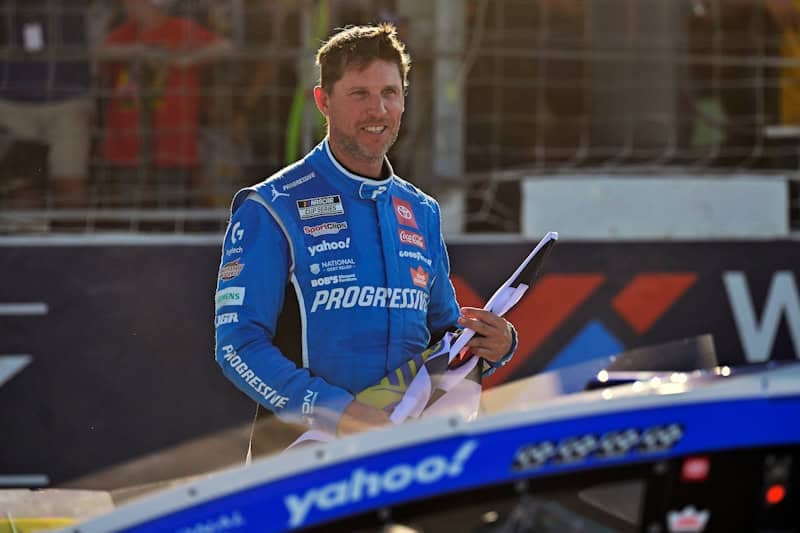Oh crikey!
One of the ledes for an article on The Athletic, one of the few general sports sites giving NASCAR quality coverage, led their post-Kansas coverage with: “Did Denny Hamlin ruin Bubba Wallace’s playoffs?”
While the article is decent and well-reasoned, it also highlights one of the disappointing elements of covering motorsports, or probably any sport, at this time.
First, Hamlin got himself into this mess.
As a driver for one company and owner of another, he’s intrinsically conflicted every time he sets out to race. Not to get weird here, but even the Bible, the best-selling book of all time, notes in Matthew 6:24-6, that no one can serve two masters; for either he will hate the one and love the other, or else he will be loyal to the one and despise the other. Now, of course, the quotation is relevant to notions of forsaking God and whatnot, but the concept is one that is found in other forms and works well for the situation here.
While racing his employee, Wallace, for the win at Kansas, Hamlin found himself in an enviable position. Knowing that he signs the checks for the driver ahead of him, he could race without care and push himself to whatever extremes while looking good for the team he actually races for.
That’s like playing with house money or something.
The Hamlin-Wallace affair deserves its share of attention because probing the economics of the sport is a topic always worthy of scrutiny as to how it plays with motivations and decisions. But the problem is that it also overshadows the coverage of the races. Chase Elliott won the damn race and doesn’t get mentioned until halfway through that same piece.
That is to say that going for the easy drama sell has become the focal point of telling the story rather than discussing craft, resources, skill, strategy and the like.
Elliott & Co. put themselves in position to win and capitalized when the opportunity came about. Depicting his race over the course of the stages and the changes that crew chief Alan Gustafson made to the car throughout is worthy of analysis. That’s boring, however, and not what seemingly works anymore.
To wit, Zak Brown, the head of Formula 1’s McLaren team, when asked about the recent sale of his McLaren Racing to Bahraini sovereign wealth fund Mumtalakat and automotive investment group CYVN Holdings, brought up the topic when also discussing the valuation of McLaren at $4.1 billion (say what??). Amidst the discussion of brands and valuation, Brown made sure to recognize how fan appeal has worked.
“[T]he on-track competition is great,” Brown said. “The off-track drama, as captured by Netflix, is fantastic. The demand for grands prix has never been stronger, so I think the sport, in many ways, is just getting going.”
Brown, in his comments, is noting an equivocation between the drama and demand.
That equation seems to be spot on.
Formula 1 had been doing well prior to the Drive to Survive series as it didn’t lack for corporate sponsorship or fans. Since the series dropped, it has exploded and become one of general pop culture consciousness.
It is not uncommon to find people wearing F1 gear as they would NFL or EPL swag at this point, showcasing how F1 sold the sport as drama and gained a whole new group of fans – while continuing to upset the old guard with technical regulations that leave them pining for the V8 naturally aspirated days (which seems rather parallel to challenge that NASCAR finds itself working with).
Hence, the selling of drama is the new click-bait, eyes on the sport method that is meant to illustrate how things matter in NASCAR. The oddity is, there’s nothing new about this technique. It’s exactly how sport rose to prominence in the late 1800s, early 1900s.
Let’s take Albert Spalding for example.
Spalding, having founded his baseball sporting goods store in 1876 has a vested interest in seeing the sport move beyond its financial instability. He recognizes how the growth of the league is good for his company.
To help things along, he encourages teams to give journalists access to the teams to help sell the stories of the sport.
Talented writers like Ring Lardner and Grantland Rice use the opportunity to embellish the sport with their own dramatic flourishes, a touch that lends itself to mythmaking and the creation of sporting idols. Rice is the one who named Notre Dame Football’s backfield The Four Horsemen and elevated the group to legendary status. That the coach, Knute Rockne, understood the value of selling Notre Dame commercially added to the whole deal.
Sportswriters in the 1960s and 70s, changed these approaches, having become more knowledgeable, but also relying on TV to help tell part of the story. Out went the heroism and in came the metrics and analysis (not on a whole-scale fashion, but in large extent). Sports didn’t need the writers to sell the sport anymore, the sports sold themselves.
But that pendulum has shifted and there is an actual need to get back into the drama. That would work better if the teams/sponsors would let them drivers loosen up so that Hamlin wasn’t the only star of the Real Drivers of Paradise NASCAR.
As a writer and editor, Ava anchors the Formula 1 coverage for the site, while working through many of its biggest columns. Ava earned a Masters in Sports Studies at UGA and a PhD in American Studies from UH-Mānoa. Her dissertation Chased Women, NASCAR Dads, and Southern Inhospitality: How NASCAR Exports The South is in the process of becoming a book.





